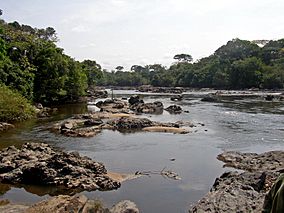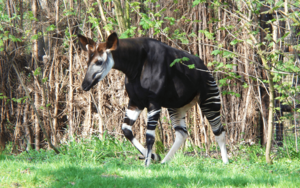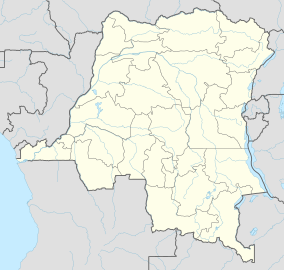Okapi Wildlife Reserve facts for kids
Quick facts for kids Okapi Wildlife Reserve |
|
|---|---|
|
IUCN Category II (National Park)
|
|

Epulu River in the Okapi Wildlife Reserve
|
|
| Location | Democratic Republic of the Congo |
| Nearest city | Isiro |
| Area | 13,726.25 km2 (5,299.73 sq mi) |
| Established | 1992 |
| Governing body | l'Institut Congolais pour la Conservation de la Nature (ICCN) |
| UNESCO World Heritage Site | |
| Criteria | Natural: x |
| Inscription | 1996 (20th Session) |
| Endangered | 1997 - |
The Okapi Wildlife Reserve (which means "Okapi Wildlife Reserve" in French) is a special place for animals and plants. It is located in the Ituri Forest in the north-east of the Democratic Republic of the Congo. This reserve is close to the borders of South Sudan and Uganda.
The reserve is huge, covering about 14,000 square kilometers. This is about one-fifth of the entire Ituri Forest! In 1996, the Okapi Wildlife Reserve became a UNESCO World Heritage Site. This means it's a very important place that needs to be protected for everyone. It was chosen because it has many endangered okapis and a wide variety of other living things.
Contents
Amazing Animals and Nature
The Okapi Wildlife Reserve is a very old forest. It has thick evergreen trees, especially a type called Mbau trees. Three rivers, the Nepoko, Ituri, and Epulu, flow through the reserve. You can also find swampy forests near these rivers. In the northern part, there are special rocks that protect a rare plant called Encephalartos ituriensis.
This forest has stayed pretty stable even during past ice ages. This means it's home to many unique animals. As its name suggests, the Okapi Wildlife Reserve is famous for its okapis. These animals look a bit like zebras but are related to giraffes! In 1996, there were an estimated 3,900 to 6,350 okapis here.
The reserve also protects many other animals. There were about 7,500 elephants and 7,500 chimpanzees in 1996. However, their numbers might have gone down because of hunting and problems in the area.
Other cool mammals living here include leopards, forest buffalos, water chevrotains, bongos, and giant forest hogs. The Ituri Forest has more types of primates than any other African forest, with 17 different species found in the reserve.
Over 370 types of birds live in the reserve, making it a key place for bird conservation in Africa. Many birds here are found only in the Congo Basin, like the endangered Congo peafowl.
The tall Mbiya Mountain stands over the Epulu village. Two groups of people, the nomadic Mbuti pygmies and Bantu farmers, also live within the reserve.
Protecting the Reserve
The Okapi Wildlife Reserve was created in 1992 with help from the Okapi Conservation Project. This project still helps the reserve today. They train and equip wildlife guards. They also help the local communities living near the reserve.
In 1997, the Okapi Wildlife Reserve was put on a list of World Heritage Sites in danger. This means it faces serious threats. The main problems are deforestation, which is when trees are cut down, often for farming. Also, hunting animals for their meat is a big issue. Gold mining has also caused problems.
Since 2005, fighting in the eastern part of the country has sometimes reached the reserve. This has made it hard for the staff to work there. It is hoped that eco-tourism, which is tourism focused on nature, can help. This would bring more money and make more people aware of the reserve's importance.
Conservation Efforts
The Epulu Conservation and Research Center is located inside the reserve, on the Epulu River. This center started in 1928. It was first used to capture wild okapis to send to zoos around the world.
Until 2012, the center still helped with okapi conservation. However, after a rebel attack in 2012, the captive okapis at the center were killed. Now, the center focuses only on protecting the wild okapis in the reserve. The center also does important research and conservation work to keep the okapis and their home safe.
Challenges from Mining
Gold mining has been a challenge for the Okapi Wildlife Reserve. In 2015, there was a gold mining camp inside the reserve with about 8,000 people. This mine was run by a rebel group. The reserve's warden started an operation to remove these groups and stop the mining.
In 2021, a United Nations report raised concerns about large mining operations within the reserve. Mining is against the law in the reserve. Even so, soldiers were guarding the mining site, which is also against the law.
Later that year, authorities seized a large amount of gold from one of these mines. As of 2022, groups working to protect the environment say that mining is destroying the beautiful rainforest within the reserve.
Rebel Attacks and Their Impact

On June 24, 2012, the Epulu Conservation and Research Center was attacked by rebels. They stole things and burned the center. During this attack, 13 of the 14 okapis at the center were killed. Six people, including two wildlife rangers, also lost their lives. Many local people were taken, but they were later set free.
By August, the security situation got better thanks to the Congolese army and wildlife guards. Work began to repair the center. With donations from all over the world, the center was rebuilt one year after the attack.
On July 14, 2017, another attack happened near Mambasa, likely by rebels. Foreign journalists and park rangers were safe. However, five local reserve employees, including four wardens, were killed. Some of the attackers also died. These events show the dangers faced by those protecting the reserve.
See also
 In Spanish: Reserva de fauna de okapis para niños
In Spanish: Reserva de fauna de okapis para niños
- Centre National d'Appui au Développement et à la Participation populaire
- Corneille Ewango
- Okapi Conservation Project


